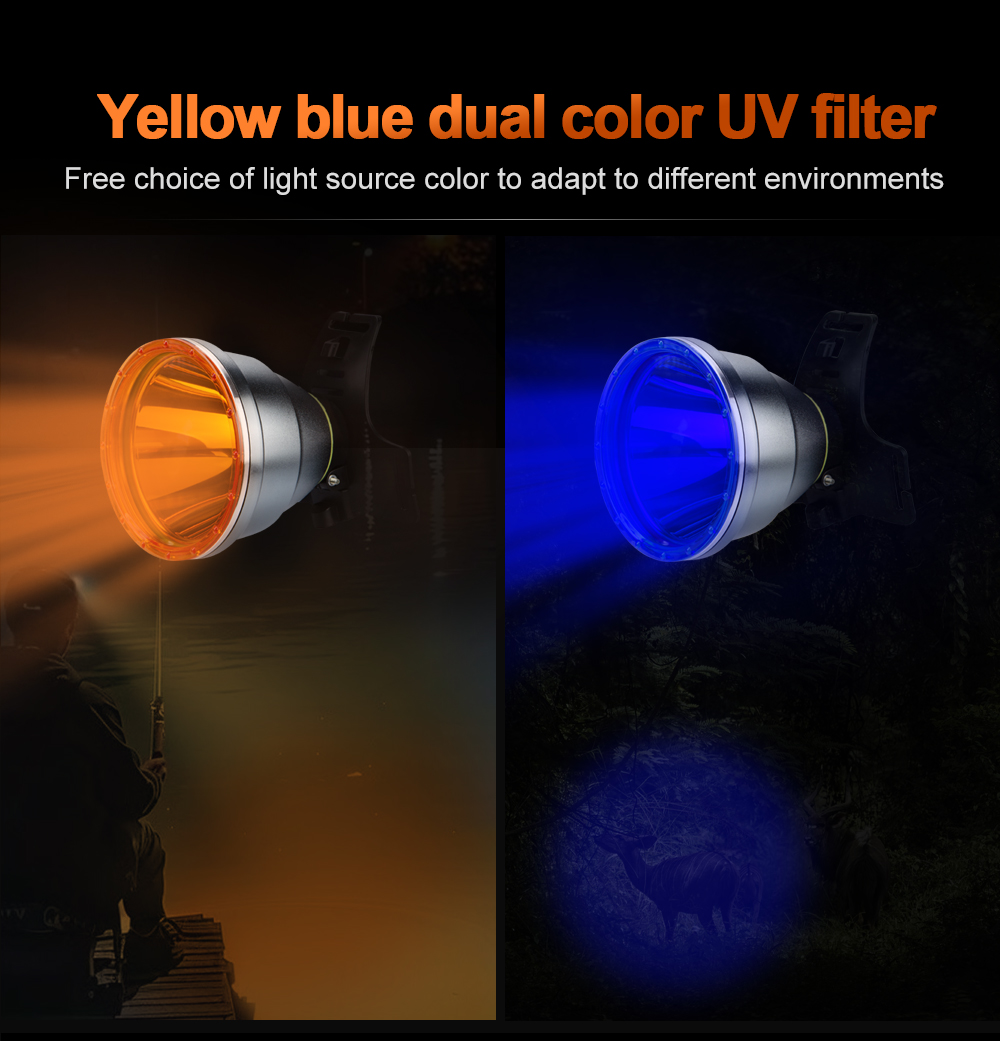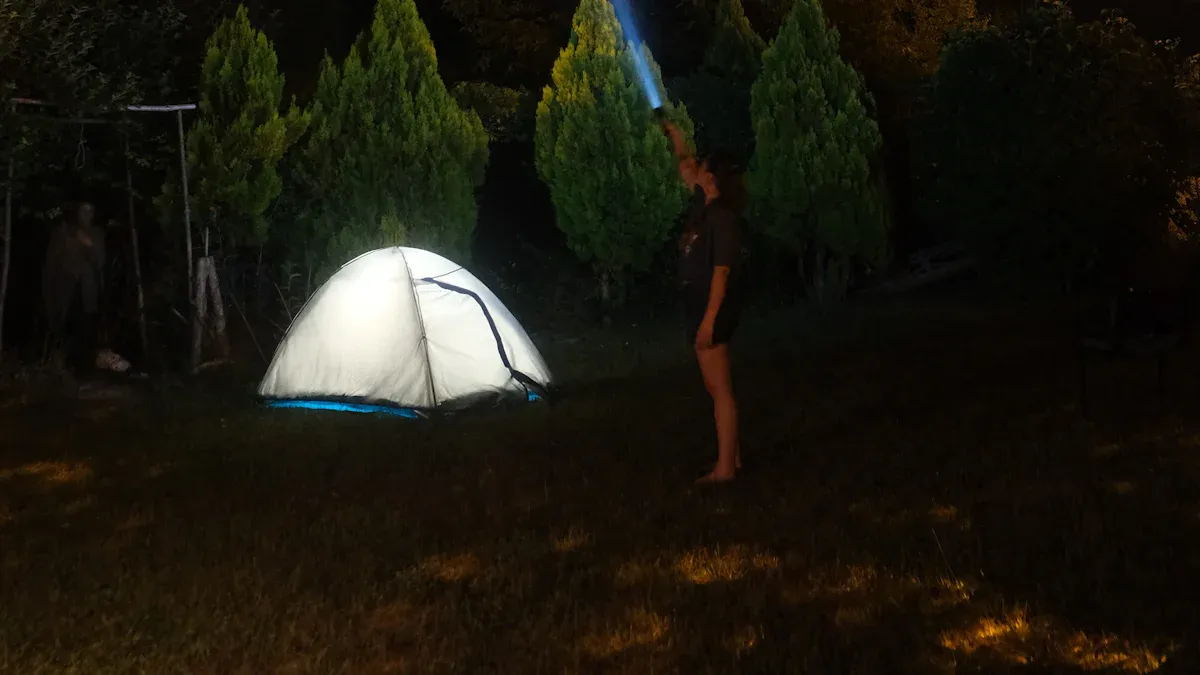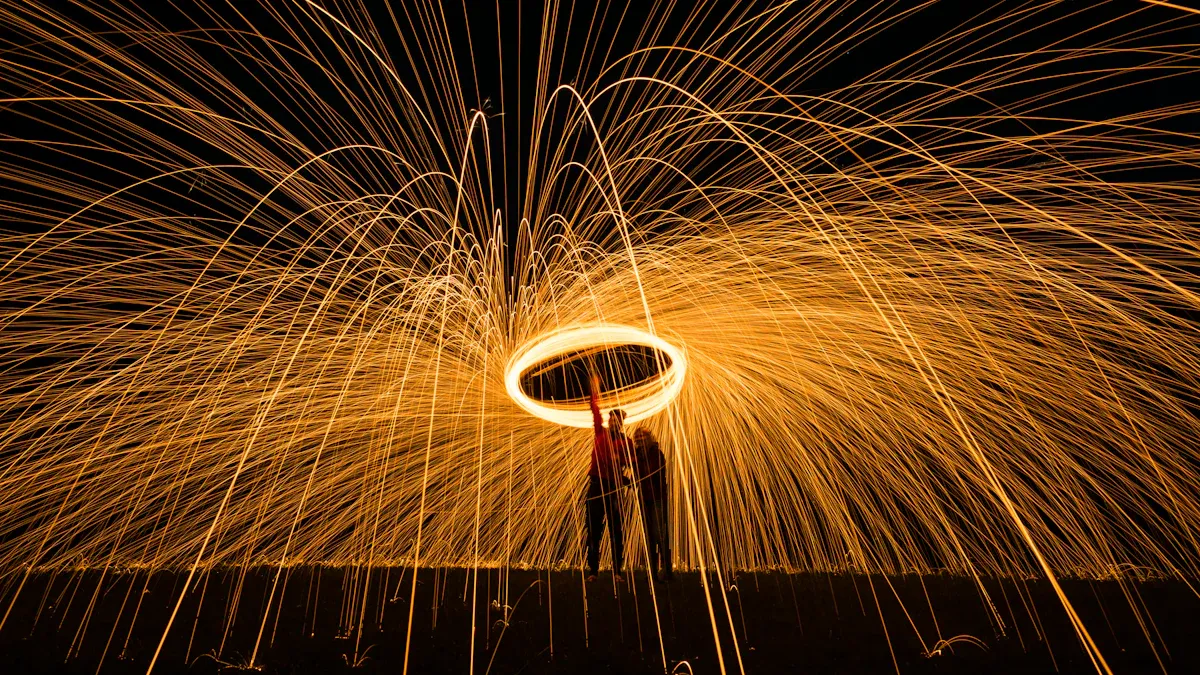Choosing the Right Flashlight Color Mix for Outdoor and Industrial Markets

Imagine working on a late-night industrial inspection or navigating a dense forest trail. Your choice of Multi-Color Flashlights can make a crucial difference in how well you see and respond to your surroundings. Studies show that the right lighting improves safety by reducing accidents and helps you distinguish colors accurately, which is essential for both outdoor adventures and hazardous environments. When you select a flashlight, consider your application, the environment, and your personal needs to ensure reliable performance and peace of mind.
Key Takeaways
Select the right flashlight color based on your environment. Cool white works best in fog, while warm tones reduce glare in dusty areas.
Prioritize durability and water resistance for outdoor and industrial use. Look for flashlights with high IP ratings to withstand harsh conditions.
Use multi-color lighting to enhance safety. Red light preserves night vision, while green light improves visibility in low-light situations.
Check for safety certifications like ATEX and UL when choosing flashlights for hazardous environments. These ensure compliance and reduce explosion risks.
Consider user preferences and specific needs. Choose flashlights with long battery life and simple controls for efficiency and ease of use.
Key Factors for Multi-Color Flashlights
Application Needs
You must match your lighting tool to your task for maximum efficiency and safety. Multi-color flashlights offer flexibility for different environments and jobs. For example, cool white beams work best outdoors in fog or rain, while warm tones reduce glare in dusty areas. Industrial settings require high CRI and Color-Rite beams for accurate color identification. The table below shows how application environments influence your choice:
Application Environment | Preferred Flashlight Color Mix | Reason for Selection |
|---|---|---|
Outdoor (open/wet) | Cool white beams | Enhances visibility in fog and rain |
Outdoor (dusty/enclosed) | Warm tones | Reduces glare and improves visibility |
Industrial | High CRI and Color-Rite beams | Accurate color representation for tasks |
General Outdoor | Neutral white beams | Versatile for various outdoor activities |
Night Activities | Red beams | Preserves night vision |
Foggy/Thick Vegetation | Green beams | Improves visibility in low light |
Fluid Detection | Blue beams | Helps in identifying spills or leaks |

Environmental Impact
Lighting performance depends on weather and terrain. You need protection against water, dust, and extreme temperatures. Durability and runtime matter most in harsh conditions. The table below highlights how environmental factors affect your flashlight:
Weather Type | Common Problems | Recommended Features |
|---|---|---|
Cold / Snow | Battery drain | Lithium-ion battery, thermal control |
Hot / Sunny | Overheating | Heat sink design |
Humid / Rainy | Condensation | IPX7–IPX8 waterproof rating |
Dusty / Windy | Lens damage | IP6X dustproof, recessed switch |
Storm / Mixed | Corrosion | O-ring seals, anti-rust coating |
Tip: Always check for water resistance and impact ratings before using your led flashlight in tough environments.
Safety Considerations
Safety remains your top priority. Multi-color lighting helps you reduce risk by improving visibility and signaling in emergencies. Layering colors, such as using red for night vision and green for low-light navigation, enhances safety and functionality. You should look for flashlights with strobe modes and color filters for signaling. Reliable lighting reduces accidents and supports protection in hazardous areas.
User Preferences
Your preferences shape your lighting experience. Outdoor users often choose cool white for brightness and clarity, while industrial workers prefer focused beams for detailed tasks. Indoor users select neutral white for a comfortable atmosphere. The table below summarizes these choices:
Sector | Preferred Flashlight Color | Reason for Preference |
|---|---|---|
Outdoor | Cool White | Provides brightness and clarity for visibility |
Industrial | Cool White | Ideal for environments needing focused light |
Indoor | Neutral White | Offers a warm and inviting atmosphere |
You should also consider battery life, cost, size, and controls. Multi-color flashlights with simple operation and long runtime improve efficiency and safety during extended use.
Multi-Color Options and Uses
White Light
You rely on white light for most outdoor and industrial tasks. This lighting enhances safety by improving visibility in open areas and workspaces. White beams reduce the risk of accidents and make spaces more inviting for users. You also benefit from a warm atmosphere that minimizes disruption to wildlife. White light encourages longer usage times in recreational areas because it reduces glare and discomfort. In industrial settings, white lighting improves branding and customer engagement by illuminating storefronts and work zones.
Red Light
Red light preserves your night vision and supports stealth in hunting or military applications. You use red beams to signal in emergencies or navigate without disturbing wildlife. This lighting mode helps you maintain focus during low-light tasks and reduces eye strain. Red light is a preferred choice for night activities because it allows you to see without drawing attention or causing glare.
Green Light
Green lighting offers enhanced visibility for hunting and fishing. You can illuminate your surroundings without alerting game or attracting insects. Green beams improve stealth since hogs and other animals have limited sensitivity to green wavelengths. You also benefit from energy efficiency when you pair green lighting with solar technology. Green light preserves night vision and reduces disturbance to wildlife, making it ideal for navigation in low-light conditions.
Benefit | Description |
|---|---|
Enhanced Visibility | Green lights illuminate the area clearly without alerting hogs or other game. |
Improved Stealth | Hogs have limited sensitivity to green wavelengths, allowing hunters to approach closer without being detected. |
Energy Efficiency | When paired with solar technology, these lights are eco-friendly and eliminate the need for batteries or external power sources. |
Blue Light
Blue lighting serves as a valuable tool for signaling and tracking. You use blue beams to detect blood or bodily fluids, which is essential for law enforcement and search operations. Blue light enhances the aesthetic appeal of outdoor spaces and creates a serene atmosphere in parks and gardens. In commercial settings, blue lighting acts as a branding tool and encourages community engagement in public areas.
UV Light
UV lighting plays a critical role in industrial inspection and outdoor activities. You use UV beams for non-destructive testing, detecting tiny cracks or flaws in materials without causing damage. UV light also helps you verify cleanliness and contamination by identifying residues and contaminants. This multi-color option supports safety and quality control in various environments.
Application Type | Description |
|---|---|
Non-Destructive Testing | UV lights are used to detect tiny cracks or flaws in materials without causing damage. |
Verification of Cleanliness and Contamination | UV lights help identify residues and contaminants, ensuring cleanliness in various settings. |
Tip: When choosing multi-color flashlights, consider your specific lighting needs and the environment to maximize safety and performance.
Outdoor Multi-Color Options

Hiking & Camping
You face unique challenges when hiking or camping at night. Multi-color flashlights provide essential lighting for navigation, campsite setup, and emergency signaling. You rely on sufficient lumens to illuminate trails, helping you spot obstacles and reduce risk. Good lighting lets you recognize animals early and scare them away, which increases your protection in outdoor hazardous locations.
Using red light in flashlights helps maintain night vision, which is crucial for safety during night hikes. Red light is less dazzling, allowing the eyes to adjust more easily to darkness after the light is turned off. This feature is particularly beneficial when reading maps or navigating in low-light conditions.
You benefit from multi-color options that include red, green, and white beams. Red light preserves your night vision and supports stealth. Green light improves visibility in thick vegetation and attracts fewer insects, making your experience more comfortable. White light offers clarity for general tasks and campsite activities.
The hiking segment is the largest application for water-activated trail marker lights, driven by increased outdoor recreational activities.
These lights are crucial for safety and navigation in low-light conditions, which is essential for activities like hiking and camping.
Flashlights designed for outdoor use often feature multiple light modes, which may include multi-color options.
Search & Rescue
You need reliable lighting when involved in search and rescue operations. Multi-color flashlights help you mark areas, guide individuals, and signal for help. You use different colors to communicate with team members and indicate safe zones or hazards. Multi-color lighting improves visibility in fog, rain, and dense forests, reducing risk and increasing the chance of successful rescue.
Search and rescue operations utilize multi-color lights for marking areas and guiding individuals, highlighting their importance in emergency situations.
The outdoor segment of the flashlight market is growing due to increased participation in camping, hiking, and emergency preparedness.
You select flashlights with strobe and SOS modes for signaling. Red and green beams help you navigate without disturbing wildlife or losing night vision. White light provides broad illumination for scanning large areas. You depend on durable, water-resistant designs to withstand harsh environments and ensure continuous protection.
Hunting & Fishing
You gain a significant advantage using multi-color flashlights during hunting and fishing trips. Lighting plays a critical role in tracking, attracting game, and maintaining stealth. You choose red beams to preserve night vision and minimize disturbance to wildlife. Green light attracts fewer insects, allowing you to focus without distractions. Blue light attracts plankton and insects, which in turn draw fish and improve your catch rate.
Color | Benefit |
|---|---|
Red | Preserves night vision and minimizes disturbance to wildlife, allowing hunters to navigate without alerting prey. |
Green | Attracts fewer insects, helping hunters and anglers maintain focus without distractions. |
Blue | Attracts plankton and insects, which in turn attract fish, enhancing fishing success. |
Many animals are less sensitive to red light, allowing hunters to use it without alerting their prey.
Green light is less attractive to insects compared to white light, reducing distractions for hunters and fishers.
Blue light effectively attracts plankton and insects, which are key in drawing fish.
You rely on multi-color lighting to adapt to changing conditions and maximize your efficiency. You reduce risk by choosing the right color for each situation, ensuring safety and protection in outdoor hazardous locations.
Industrial Safety and Hazardous Lighting

Maintenance & Inspection
You face unique challenges when performing maintenance and inspection tasks in industrial settings. You need lighting that delivers reliability and safety in hazardous environments. Multi-color flashlights provide you with flexibility, allowing you to switch between beams for different inspection needs. You must prioritize intrinsically safe lighting to prevent explosion risks in areas with flammable gases or dust.
When you select a flashlight for maintenance, consider these essential features:
Durability: Choose flashlights made from aluminum or stainless steel. These materials withstand drops and bumps, ensuring long-term protection.
Brightness: You need at least 1000 lumens for effective inspections. High brightness helps you spot issues quickly and maintain safety.
Battery Life: Long-lasting batteries minimize downtime. You can complete tasks efficiently without frequent recharging.
Hands-Free Options: Headlamps or clip-on designs allow you to work with both hands, improving efficiency and safety.
Water and Chemical Resistance: High IP ratings protect your flashlight from water and chemicals. This feature is vital in hazardous environments.
Safety Certifications: Always check for certifications that confirm compliance with safety standards. Certified flashlights reduce explosion risks and support safe operation.
Tip: You should inspect your lighting equipment regularly to ensure all safety features function correctly. This practice helps you maintain protection and avoid unexpected failures.
Emergency Response
You must act quickly and decisively during emergencies in hazardous environments. Intrinsically safe lighting plays a critical role in your response strategy. You rely on multi-color flashlights to signal, navigate, and communicate in low-visibility conditions. Red and green beams help you mark safe zones and guide team members without causing confusion.
You need flashlights that offer:
Rapid switching between colors for clear communication.
Strobe and SOS modes for signaling in explosion-prone areas.
Water-resistant and impact-resistant designs for durability during rescue operations.
Intrinsically safe lighting that meets strict safety standards and certifications.
You should select lighting tools with proven runtime and reliability. These features ensure you maintain safety and protection throughout emergency situations. You also benefit from cost-effective models that deliver high performance without compromising safety.
Note: Emergency response teams in chemical processing plants and mining operations depend on intrinsically safe lighting to avoid explosion hazards and maintain compliance with safety standards.
Hazardous Environments
You encounter the highest risks in hazardous environments, such as chemical processing plants, oil refineries, and mining sites. Intrinsically safe lighting is mandatory in these locations to prevent explosion incidents. You must choose flashlights that meet explosion-proof standards and carry the necessary certifications.
The following table summarizes key regulatory safety standards and certifications for industrial flashlights:
Standard | Description | Application |
|---|---|---|
ATEX | European certification for equipment in explosive atmospheres, classifying equipment into zones based on risk. | Used in Europe, particularly in industries like oil and gas. |
IECEx | International certification system for equipment in explosive environments, ensuring global safety standards. | Applicable in multinational operations across various industries. |
UL | North American certification for safety in environments with flammable gases, with specific divisions for different hazard levels. | Commonly used in chemical plants and mining operations. |
You must verify that your lighting equipment meets these safety standards before entering hazardous environments. Intrinsically safe lighting prevents ignition of flammable substances and reduces explosion risks. You should look for flashlights with multiple certifications to ensure compliance and maximize protection.
You also need to consider durability, water resistance, and cost when selecting lighting for hazardous environments. Flashlights with high IP ratings and robust construction withstand harsh conditions and extend runtime. Cost-effective options help you manage budgets while maintaining safety and efficiency.
Callout: Always check for certifications such as ATEX, IECEx, and UL before using lighting in hazardous environments. These certifications guarantee compliance with safety standards and minimize explosion risks.
You rely on intrinsically safe lighting to protect yourself and your team. Multi-color flashlights enhance visibility, support communication, and improve safety in hazardous environments. You must prioritize safety standards, certifications, and explosion-proof features to ensure reliable protection and efficient operations.
Selecting Multi-Color Flashlights
Decision Checklist
You need a clear checklist to select the best multi-color flashlight for your application. Consider the following top flashlight features and specifications to maximize safety and minimize risk:
Item Category | Checklist Items |
|---|---|
User Interface | Simple on-off, Multiple light levels, Programmable light, Strobe mode, SOS mode, Beacon mode |
Material/Finish | Plastic, Anodized Aluminum, Stainless Steel, Titanium |
Water Resistance | None, IPX4, IPX7, IPX8 |
Storage Conditions | In house, Emergency kit, Automobile glove-box |
Special Needs/Extras | Red filter, Other filter colors, Dedicated R/G/B secondary LEDs, Pocket/belt clip |
Emitter/Light Source | LED, Incandescent, HID |
Manufacturer | Large/traditional manufacturer, Specialty manufacturer, Assembling own components |
Power Source | Disposable Alkaline, Disposable Lithium, Rechargeable cells, Integrated rechargeable battery pack |
Light Output | 1-10 lumens, 15-50 lumens, 60-150 lumens, 150-300 lumens, 800+ lumens |
Beam Type | All Flood, Wide Flood, Narrow Flood, Wide Throw, Narrow Throw, Turbohead |
Tip: Rechargeable flashlights with long runtime and high energy efficiency offer the best value for frequent use.
Comparison Table
You should compare multi-color flashlights based on lighting modes, rechargeable options, runtime, and advancements in led technology. The table below highlights key differences:
Feature | Model A (Outdoor) | Model B (Industrial) | Model C (EDC) |
|---|---|---|---|
Lighting Modes | White, Red, Green | White, Blue, UV | White, Yellow |
Rechargeable | Yes | Yes | Yes |
Runtime | Long runtime | Long runtime | Long runtime |
Water Resistance | IPX7 | IPX8 | IPX4 |
Energy Efficiency | High | High | Moderate |
Advancements in LED Technology | Advanced optics | High CRI LEDs | Standard LEDs |
Cost | Moderate | High | Low |
Work Light | Yes | Yes | No |
User Scenarios
You encounter different needs depending on your environment and task. Multi-color rechargeable flashlights adapt to each scenario:
You use flood patterns for hiking and outdoor recreation, which provide broad lighting for close-range tasks.
You select balanced beam patterns for automotive and maintenance work light, ensuring medium-range visibility and safety.
You rely on throw-focused patterns for long-range outdoor settings, maximizing lighting distance and reducing risk.
You choose moderate beam patterns for general EDC and household use, balancing lighting quality and energy efficiency.
Advancements in led technology and rechargeable flashlights deliver superior lighting performance and long runtime, making them ideal for demanding environments.
You should always match your flashlight’s color mix to your specific needs. Red light retains night vision and does not attract insects. Blue light enhances detail visibility for map reading. Green light is soft on the eyes and less noticeable to animals. Yellow light maintains night vision while allowing color distinction. Rechargeable flashlights with multiple lighting modes and long runtime help you stay prepared and safe in any situation.
You improve safety and efficiency by choosing multi-color flashlights that match your specific lighting needs. The most effective options for outdoor and industrial use include models with white, green, red, and blue lighting. The table below highlights top choices:
Feature | DUALIE® 3AA COLOR-RITE® | NITECORE UT27 | MiX-7 Gen 2 |
|---|---|---|---|
Multi-Color Capabilities | Green LED, blue taillight | 3000K, 4500K, 6500K | Red, blue, green, UV |
Maximum Output | N/A | 800 lumens | 2000 lumens |
Waterproof Rating | N/A | IP66 | IPX-8 |
You should use the checklist to compare lighting features, durability, and battery life. Test different lighting modes in real-world conditions to find the best fit for your tasks. Reliable lighting supports your work and outdoor activities, helping you stay prepared and protected.
White lighting works well in most environments.
Green lighting lasts longer and does not scare animals.
Red lighting helps you see better in bright conditions.
Blue lighting assists with tracking and inspection.
Tip: Always match your lighting choice to your environment and application for optimal results.
FAQ
What are the most important standards for industrial flashlights?
You must follow standards like ATEX, IECEx, and UL. These standards ensure your flashlight meets safety requirements for hazardous environments. Always check for certifications before using your flashlight in industrial settings.
How do standards affect outdoor flashlight performance?
Standards guide manufacturers to create flashlights that withstand harsh weather and rough terrain. You benefit from reliable water resistance, impact protection, and long battery life. Standards help you choose the right tool for outdoor activities.
Why should you care about standards when buying a multi-color flashlight?
You protect yourself by choosing flashlights that meet strict standards. These standards guarantee safety, durability, and performance. You avoid risks in hazardous areas and ensure your flashlight works as expected.
Which standards should you look for in emergency response lighting?
You need flashlights certified to ATEX, IECEx, or UL standards. These standards confirm your lighting tool is safe for explosive atmospheres. You improve team safety and reduce the chance of accidents during emergencies.
Do standards impact the cost of multi-color flashlights?
You may pay more for flashlights that meet advanced standards. These standards require better materials and testing. You gain peace of mind knowing your flashlight will perform safely and reliably in demanding conditions.
See Also
The Ultimate Guide to Selecting Color Flashlights for Outdoors
Selecting the Ideal Color Flashlight for Hog Hunting Adventures
Tips for Selecting the Perfect Headlamp Flashlight
